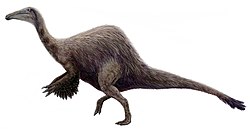Arthropods
Newly named insects
| Name | Novelty | Status | Authors | Age | Unit | Location | Notes | Images |
|---|---|---|---|---|---|---|---|---|
Sp nov | Valid | Fujiyama | A myrmicin ant | |||||
Fam nov | nomen nudum | A scorpionfly family, type sp. H. maculosa | ||||||
| |||
|---|---|---|---|
| +... | |||
Paleontology or palaeontology is the study of prehistoric life forms on Earth through the examination of plant and animal fossils . [1] This includes the study of body fossils, tracks ( ichnites ), burrows , cast-off parts, fossilised feces ( coprolites ), palynomorphs and chemical residues . Because humans have encountered fossils for millennia, paleontology has a long history both before and after becoming formalized as a science . This article records significant discoveries and events related to paleontology that occurred or were published in the year 1970.
| Name | Novelty | Status | Authors | Age | Unit | Location | Notes | Images |
|---|---|---|---|---|---|---|---|---|
Sp nov | Valid | Fujiyama | A myrmicin ant | |||||
Fam nov | nomen nudum | A scorpionfly family, type sp. H. maculosa | ||||||
| Name | Novelty | Status | Authors | Age | Location | Notes | Images |
|---|---|---|---|---|---|---|---|
fam et gen et sp nov | valid | possible gliding reptile covered with Feather-like Scales. |  | ||||
Data courtesy of George Olshevsky's dinosaur genera list. [5]
| Name | Novelty | Status | Authors | Age | Unit | Location | Notes | Images |
|---|---|---|---|---|---|---|---|---|
gen et sp nov | Valid | A tyrannosaurine tyrannosaurid. |  | |||||
fam, gen et sp nov | Valid | Osmólska & Roniewicz |  | |||||
gen nov | Valid | Welles | A Two-crested Dilophosaur. |  | ||||
" Likhoelesaurus " [9] | gen et sp nov | Ellenberger | Misidentified non-dinosaurian archosaur. | |||||
gen et sp nov | Chimera of Deinonychus and Microvenator . | |||||||
gen et sp nov | Valid |  | ||||||
gen et sp nov | Valid |  | ||||||
gen et sp nov | Valid |  | ||||||
gen et sp nov | Valid | an ornithopod. with a Long Tail. | ||||||
| Name | Novelty | Status | Authors | Age | Unit | Location | Notes | Images |
|---|---|---|---|---|---|---|---|---|
Sp. nov. | jr synonym | An Anatidae, jr synonym of Brantadorna robusta [14] | ||||||
Sp. nov. | jr synonym | Cave deposits | An Accipitridae, jr synonym of Buteogallus borrasi . [16] | |||||
Gen. nov. et Sp. nov. | valid | Early Miocene | A Spheniscidae, this is the type species of the new genus, Carolina Acosta Hospitaleche, 2007 transferred the species to the genus Palaeospheniscus Moreno et Mercerat, 1891. [18] | |||||
Gen. nov. et Sp. nov. | valid | Early Pliocene | An Anatidae, this is the type species of the new genus. | |||||
Sp. nov. | valid | Middle Pliocene |
| An Alcidae, Mancallinae. | ||||
Gen. nov. et Sp. nov. | valid | Early Eocene | Described as a Bucconidae, Feduccia et Martin, 1976 erected the family Primobucconidae for it, [21] this is the type species of the new genus. | |||||
Gen. nov. et Sp. nov. | valid | Late Pliocene | A Meleagridae, this is the type species of the new genus. | |||||
Gen. nov. et Sp. nov. | valid | Late Miocene | A Spheniscidae, this is the type species of the new genus. | |||||
Sp. nov. | valid | Late Miocene | A Spheniscidae. | |||||
Sp. nov. | valid | Late Pliocene | A Scolopacidae. | |||||
Sp. nov. | valid | Middle Pleistocene | Miramar | |||||
| Name | Novelty | Status | Authors | Age | Unit | Location | Notes | Images |
|---|---|---|---|---|---|---|---|---|
gen et sp nov | Valid | Bonaparte | a Ctenochasmatid pterodactyloid. with a Flamingo-like feeding style. |  | ||||